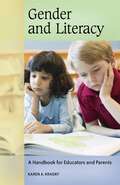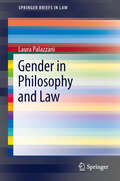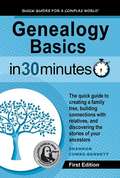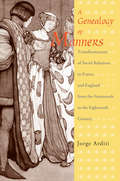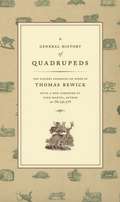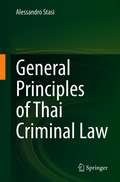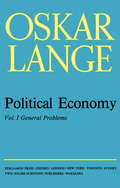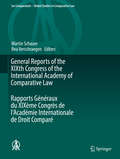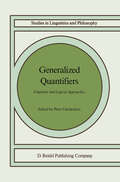- Table View
- List View
Gender and Literacy: A Handbook for Educators and Parents (Handbooks for Educators and Parents)
by Karen A. KrasnyThis work offers parents, educators, and librarians a practical guide to discovering the ways gender identities are constructed through literacy practices, providing recommendations for addressing gender inequities in schools and in the community at large.Gender and Literacy: A Handbook for Educators and Parents focuses on issues related to the gendered experience of students from pre-kindergarten through grade 12, promoting an understanding that the issues surrounding gender cannot be reduced to broad generalizations. Author Karen A. Krasny seeks to make clear the complex notion of gender construction within the context of redefining what constitutes legitimate literacy practices in schools.This handbook will help to guide educators, parents, and librarians by assisting them in the selection and evaluation of print and media resources. The first chapter explains the need to understand the complex relationship between gender and literacy. The bulk of the book provides readers with a critical review of the studies conducted to investigate gendered literacy practices, while the last three chapters focus on actionable strategies and policy making.
Gender in Philosophy and Law (SpringerBriefs in Law)
by Laura PalazzaniThis book is an introductory systematic framework in the complex and interdisciplinary sex/gender debate, focusing on philosophy of law.The volume analyses the different theories that have dealt with the gender category, highlighting the conceptual premises and the arguments of the most influential theories in the debate, which have had repercussions on the field of the ethical and juridical debate (with reference to intersexuality, transsexualism, transgender, homosexuality). The aim is to offer a sort of conceptual orientation in the complexity of the debate, in an effort to identify the various aspects and development processes of the theories, so as to highlight the conceptual elements of the theorisations to grasp the problem areas within them. It is therefore an overall synthetic and also explicative analysis, but not only explicative: the aim is to outline the arguments supporting the different theories and the counter-arguments too, for the purpose of proposing categories to weigh up the elements and to take one’s own critical stance, with a methodological style that is neither descriptive nor prescriptive, but critical.
The Gene: An Intimate History
by Siddhartha MukherjeeSelected as a Book of the Year by The New York Times, The Economist, Independent, Observer and Mail on SundayTHE NEW YORK TIMES NUMBER ONE BESTSELLER SHORTLISTED FOR THE WELLCOME BOOK PRIZE 2017 ‘Dramatic and precise… [A] thrilling and comprehensive account of what seems certain to be the most radical, controversial and, to borrow from the subtitle, intimate science of our time… He is a natural storyteller… A page-turner… Read this book and steel yourself for what comes next’Bryan Appleyard, Sunday TimesThe Gene is the story of one of the most powerful and dangerous ideas in our history, from bestselling, prize-winning author Siddhartha Mukherjee.Spanning the globe and several centuries, The Gene is the story of the quest to decipher the master-code that makes and defines humans, that governs our form and function. This is an epic, moving history of a scientific idea coming to life, by the author of The Emperor of All Maladies. But woven through The Gene, like a red line, is also an intimate history – the story of Mukherjee’s own family and its recurring pattern of mental illness, reminding us that genetics is vitally relevant to everyday lives. These concerns reverberate even more urgently today as we learn to “read” and “write” the human genome – unleashing the potential to change the fates and identities of our children. The story of the gene begins in an obscure Augustinian abbey in Moravia in 1856 where a monk stumbles on the idea of a ‘unit of heredity’. It intersects with Darwin’s theory of evolution, and collides with the horrors of Nazi eugenics in the 1940s. The gene transforms post-war biology. It reorganizes our understanding of sexuality, temperament, choice and free will. This is a story driven by human ingenuity and obsessive minds – from Charles Darwin and Gregor Mendel to Francis Crick, James Watson and Rosalind Franklin, and the thousands of scientists still working to understand the code of codes.Majestic in its ambition, and unflinching in its honesty, The Gene gives us a definitive account of the fundamental unit of heredity – and a vision of both humanity’s past and future.
The Genealogist's Internet: The Essential Guide to Researching Your Family History Online (Genealogist's Guides Ser.)
by Peter ChristianThis practical guide identifies the major websites and online sources of data available to family historians. It is ideal for both beginners and more experienced researchers as it explores the most useful sources and helps readers to navigate each one. The Genealogist's Internet features fully updated URLs and all of the recent developments in online genealogy. This fully updated fifth edition, endorsed by the National Archives, is the comprehensive guide for anyone researching their family history online. It covers:·Online census records and wills, including the 1911 Census·Civil registration indexes·Information on occupations and professions·DNA matching·New genealogy websites and search engines·Surname studies·Passenger lists and migration records·Information on digitised historical maps and photographsThis book also includes the impact of blogging, podcasting and social networking on family history research, allowing family historians to find others with similar research interests and to share their results. Whether you want to put your family tree online, find distant relatives or access the numerous online genealogical forums, discussion groups and mailing lists, this book is a must-have.
Genealogy Basics In 30 Minutes: The Quick Guide To Creating A Family Tree, Building Connections With Relatives, And Discovering The Stories Of Your Ancestors
by Shannon Combs-BennettGenealogists are like detectives. Working out puzzles is the name of their game! In the award-winning Genealogy Basics In 30 Minutes, professional genealogist Shannon Combs-Bennett explains the joys, challenges, and triumphs of researching your family's origins. Topics include research best practices, connecting with relatives, genetic genealogy, solving "brick wall" mysteries, genealogy road trips, and how to share charts, data, and family stories.
Genealogy For Dummies (For Dummies)
by Matthew L. Helm April Leigh HelmThe fun way to research your family history Genealogy For Dummies, 8th Edition covers everything you need to know about starting a genealogical research project—including where and how to find information, how to communicate with other online genealogists, how to leverage social networking sites and apps, how to add digital images to your family tree, and how to build your own site for sharing information. It also explains the use of compiled genealogies, U.S. Census information, and public access catalogs. Brand new to this edition is content on how to conduct genealogical research on the road, and on how to take this research and integrate it into the data found at home. It also contains new information on DNA research and testing, new geocoding applications to record geographic data into a genealogical database, and other new technologies. The book covers which apps are worth your money, and how to get the most out of them. Use the latest tools to research family history Create your own site to showcase your family tree, digital images, and compiled genealogies Get access to free versions of Legacy Family Tree and Personal Ancestral Files Utilize both online and offline research techniques and tools Follow the clues to uncover your family's legacy—and have fun along the way!
Genealogy For Dummies
by Matthew L. Helm April Leigh HelmThe fun way to research your family history Genealogy For Dummies, 8th Edition covers everything you need to know about starting a genealogical research project—including where and how to find information, how to communicate with other online genealogists, how to leverage social networking sites and apps, how to add digital images to your family tree, and how to build your own site for sharing information. It also explains the use of compiled genealogies, U.S. Census information, and public access catalogs. Brand new to this edition is content on how to conduct genealogical research on the road, and on how to take this research and integrate it into the data found at home. It also contains new information on DNA research and testing, new geocoding applications to record geographic data into a genealogical database, and other new technologies. The book covers which apps are worth your money, and how to get the most out of them. Use the latest tools to research family history Create your own site to showcase your family tree, digital images, and compiled genealogies Get access to free versions of Legacy Family Tree and Personal Ancestral Files Utilize both online and offline research techniques and tools Follow the clues to uncover your family's legacy—and have fun along the way!
A Genealogy of Manners: Transformations of Social Relations in France and England from the Fourteenth to the Eighteenth Century
by Jorge ArditiRemarkable for its scope and erudition, Jorge Arditi's new study offers a fascinating history of mores from the High Middle Ages to the Enlightenment. Drawing on the pioneering ideas of Norbert Elias, Michel Foucault, and Pierre Bourdieu, Arditi examines the relationship between power and social practices and traces how power changes over time. Analyzing courtesy manuals and etiquette books from the thirteenth to the eighteenth century, Arditi shows how the dominant classes of a society were able to create a system of social relations and put it into operation. The result was an infrastructure in which these classes could successfully exert power. He explores how the ecclesiastical authorities of the Middle Ages, the monarchies from the fifteenth through the seventeenth century, and the aristocracies during the early stages of modernity all forged their own codes of manners within the confines of another, dominant order. Arditi goes on to describe how each of these different groups, through the sustained deployment of their own forms of relating with one another, gradually moved into a position of dominance.
Genealogy of Nihilism (Routledge Radical Orthodoxy)
by Conor CunninghamThis text re-reads Western history in the light of nihilistic logic, which pervades two millennia of Western thought. From Parmenides to Alain Badiou, via Plotinus, Avicenna, Duns Scotus, Ockham, Descartes, Spinoza, Kant, Hegel, Heidegger, Sartre, Lacan, Deleuze and Derrida, a genealogy of nothingness can be witnessed in development, with devastating consequences for the way we live.
Genealogy of Nihilism (Routledge Radical Orthodoxy)
by Conor CunninghamThis text re-reads Western history in the light of nihilistic logic, which pervades two millennia of Western thought. From Parmenides to Alain Badiou, via Plotinus, Avicenna, Duns Scotus, Ockham, Descartes, Spinoza, Kant, Hegel, Heidegger, Sartre, Lacan, Deleuze and Derrida, a genealogy of nothingness can be witnessed in development, with devastating consequences for the way we live.
General Equilibrium, Growth, and Trade: Essays in Honor of Lionel McKenzie
by Jerry R. Green Josè Alexandre ScheinkmanGeneral Equilibrium, Growth, and Trade: Essays in Honor of Lionel McKenzie provides information pertinent to the three main areas of Professor McKenzie's scientific research, namely, international trade, economic growth, and general equilibrium theory. This book highlights the main aspects of McKenzie's work.Organized into three parts encompassing 21 chapters, this book begins with an overview of the regularizing effects of aggregation over nonregular microrelations. This text then examines the theory of a multiperiod monopolist incurring nonseparable labor adjustment costs, which is developed when investment is irreversible. Other chapters consider the behavior of a price-maker in a competitive market as a preliminary step to a more complete analysis of pure competition. This book discusses as well the effects of uncertainty on optimal decisions, which constitutes an increasingly essential area of economic research. The final chapter deals with the general equilibrium macroeconomic model.This book is a valuable resource for economists and economic theorists.
General Equilibrium, Growth, and Trade II: The Legacy of Lionel McKenzie
by Robert Becker Michele Boldrin Ronald JonesGeneral Equilibrium, Growth, and Trade, Volume II: The Legacy of Lionel McKenzie presents the impact of Lionel McKenzie's contributions on modern economics. This book discusses McKenzie's researches that are relevant in applied economic fields, including general equilibrium, optimal growth, and international trade.Organized into three parts encompassing 24 chapters, this volume begins with an overview of the existence of competitive equilibrium in an economy with a finite number of agents and commodities. This text then presents two analyses that are basically responses to criticism of the development of real indeterminacy. Other chapters consider McKenzie's assumption of irreducibility, which plays a significant role in showing how compensated equilibria will be uncompensated equilibria because agents have cheaper net trade vectors in their feasible sets. This book discusses as well some properties of competitive equilibria for dynamic exchange economies with an infinite horizon and incomplete financial markets.This book is a valuable resource for economists and economic theorists.
A General History of Quadrupeds: The Figures Engraved on Wood
by Thomas BewickIn the late eighteenth century, the British took greater interest than ever before in observing and recording all aspects of the natural world. Travelers and colonists returning from far-flung lands provided dazzling accounts of such exotic creatures as elephants, baboons, and kangaroos. The engraver Thomas Bewick (1753–1828) harnessed this newfound interest by assembling the most comprehensive illustrated guide to nature of his day. A General History of Quadrupeds, first published in 1790, showcases Bewick’s groundbreaking engraving techniques that allowed text and images to be published on the same page. From anteaters to zebras, armadillos to wolverines, this delightful volume features engravings of over four hundred animals alongside descriptions of their characteristics as scientifically understood at the time. Quadrupeds reaffirms Bewick’s place in history as an incomparable illustrator, one whose influence on natural history and book printing still endures today.
A General History of Quadrupeds: The Figures Engraved on Wood
by Thomas BewickIn the late eighteenth century, the British took greater interest than ever before in observing and recording all aspects of the natural world. Travelers and colonists returning from far-flung lands provided dazzling accounts of such exotic creatures as elephants, baboons, and kangaroos. The engraver Thomas Bewick (1753–1828) harnessed this newfound interest by assembling the most comprehensive illustrated guide to nature of his day. A General History of Quadrupeds, first published in 1790, showcases Bewick’s groundbreaking engraving techniques that allowed text and images to be published on the same page. From anteaters to zebras, armadillos to wolverines, this delightful volume features engravings of over four hundred animals alongside descriptions of their characteristics as scientifically understood at the time. Quadrupeds reaffirms Bewick’s place in history as an incomparable illustrator, one whose influence on natural history and book printing still endures today.
A General History of Quadrupeds: The Figures Engraved on Wood
by Thomas BewickIn the late eighteenth century, the British took greater interest than ever before in observing and recording all aspects of the natural world. Travelers and colonists returning from far-flung lands provided dazzling accounts of such exotic creatures as elephants, baboons, and kangaroos. The engraver Thomas Bewick (1753–1828) harnessed this newfound interest by assembling the most comprehensive illustrated guide to nature of his day. A General History of Quadrupeds, first published in 1790, showcases Bewick’s groundbreaking engraving techniques that allowed text and images to be published on the same page. From anteaters to zebras, armadillos to wolverines, this delightful volume features engravings of over four hundred animals alongside descriptions of their characteristics as scientifically understood at the time. Quadrupeds reaffirms Bewick’s place in history as an incomparable illustrator, one whose influence on natural history and book printing still endures today.
A General History of Quadrupeds: The Figures Engraved on Wood
by Thomas BewickIn the late eighteenth century, the British took greater interest than ever before in observing and recording all aspects of the natural world. Travelers and colonists returning from far-flung lands provided dazzling accounts of such exotic creatures as elephants, baboons, and kangaroos. The engraver Thomas Bewick (1753–1828) harnessed this newfound interest by assembling the most comprehensive illustrated guide to nature of his day. A General History of Quadrupeds, first published in 1790, showcases Bewick’s groundbreaking engraving techniques that allowed text and images to be published on the same page. From anteaters to zebras, armadillos to wolverines, this delightful volume features engravings of over four hundred animals alongside descriptions of their characteristics as scientifically understood at the time. Quadrupeds reaffirms Bewick’s place in history as an incomparable illustrator, one whose influence on natural history and book printing still endures today.
A General History of Quadrupeds: The Figures Engraved on Wood
by Thomas BewickIn the late eighteenth century, the British took greater interest than ever before in observing and recording all aspects of the natural world. Travelers and colonists returning from far-flung lands provided dazzling accounts of such exotic creatures as elephants, baboons, and kangaroos. The engraver Thomas Bewick (1753–1828) harnessed this newfound interest by assembling the most comprehensive illustrated guide to nature of his day. A General History of Quadrupeds, first published in 1790, showcases Bewick’s groundbreaking engraving techniques that allowed text and images to be published on the same page. From anteaters to zebras, armadillos to wolverines, this delightful volume features engravings of over four hundred animals alongside descriptions of their characteristics as scientifically understood at the time. Quadrupeds reaffirms Bewick’s place in history as an incomparable illustrator, one whose influence on natural history and book printing still endures today.
A General History of Quadrupeds: The Figures Engraved on Wood
by Thomas BewickIn the late eighteenth century, the British took greater interest than ever before in observing and recording all aspects of the natural world. Travelers and colonists returning from far-flung lands provided dazzling accounts of such exotic creatures as elephants, baboons, and kangaroos. The engraver Thomas Bewick (1753–1828) harnessed this newfound interest by assembling the most comprehensive illustrated guide to nature of his day. A General History of Quadrupeds, first published in 1790, showcases Bewick’s groundbreaking engraving techniques that allowed text and images to be published on the same page. From anteaters to zebras, armadillos to wolverines, this delightful volume features engravings of over four hundred animals alongside descriptions of their characteristics as scientifically understood at the time. Quadrupeds reaffirms Bewick’s place in history as an incomparable illustrator, one whose influence on natural history and book printing still endures today.
General Principles of Law - The Role of the Judiciary (Ius Gentium: Comparative Perspectives on Law and Justice #46)
by Laura PineschiThis book examines the role played by domestic and international judges in the “flexibilization” of legal systems through general principles. It features revised papers that were presented at the Annual Conference of the European-American Consortium for Legal Education, held at the University of Parma, Italy, May 2014. This volume is organized in four sections, where the topic is mainly explored from a comparative perspective, and includes case studies. The first section covers theoretical issues. It offers an analysis of principles in shaping Dworkin’s theories about international law, a reflection on the role of procedural principles in defining the role of the judiciary, a view on the role of general principles in transnational judicial communication, a study on the recognition of international law from formal criteria to substantive principles, and an inquiry from the viewpoint of neo-constitutionalism.The second section contains studies on the role of general principles in selected legal systems, including International Law, European Union Law as well as Common Law systems. The third section features an analysis of select legal principles in a comparative perspective, with a particular focus on the comparison between European and American experiences. The fourth and last section explores selected principles in given areas of law, including the misuse of the lex specialis principle in the relationship between international human rights law and international humanitarian law, the role of the judiciary in Poland as regards discrimination for sexual orientation, and the impact of the ECtHR case law on Italian criminal law with regard to the principle of legality.Overall, the book offers readers a thoughtful reflection on how the interpretation, application, and development of general principles of law by the judiciary contribute to the evolution of legal systems at both the domestic and international levels as well as further their reciprocal interactions.
General Principles of Thai Criminal Law
by Alessandro StasiThis book is centered around the major issues relating to criminal law in Thailand and aims to offer a detailed and systematic overview of the Thai criminal justice system. It is designed as a traditional textbook of criminal law which provides a succinct focused coverage of all the relevant aspects of laws, judgments, and legal reforms in a concise and readable form. Although all topics have been previously treated in the Thai language, this is the first and most comprehensive work in the English language about Thai criminal law. The book covers not only the legal system, starting from the Penal Code of 1908 and emphasizing the substantial changes that have been introduced in the past decades, but also the deep influence of doctrine and case law. It is built up in several layers, starting from the general rule, to gradually examine the more specific ones. The book begins with the elementary legal concepts to be learned by the reader, by defining the fundamental principles underlying the Thai criminal system and outlining its objectives. It then extensively describes the main offences under the Thai Penal Code and classifies those breaches of law which are crimes from those which are merely illegal without being criminal.
General Problems: Political Economy
by Oskar LangePolitical Economy, Volume I: General Problems provides a systematic treatise on political economy. This book discusses the state of economic science and the course of economic development in different parts of the world. Organized into seven chapters, this volume begins with an overview of the social or political economy as the study of social laws governing the production and distribution of the material means of satisfying human needs. This text then examines the basic regularity encountered by political economy in its analysis of the social laws governing human economic activity, which is formed by the dependence of production relations on social productive forces. Other chapters consider the objective character of economic laws. This book discusses as well the concern of economic history in the development of concrete economic progress. The final chapter deals with the differences of opinions and interpretations in the development of science. Economists will find this book useful.
General Reports of the XIXth Congress of the International Academy of Comparative Law Rapports Généraux du XIXème Congrès de l'Académie Internationale de Droit Comparé (Ius Comparatum - Global Studies in Comparative Law #24)
by Martin Schauer Bea VerschraegenThis book deals with convergences of legal doctrine despite jurisdictional, cultural, and political barriers, and of divergences due to such barriers, examining topics that are of vital importance to contemporary legal scholars. Written by leading scholars from more than twenty countries, its thirty-two chapters present a comparative analysis of cutting-edge legal topics of the 21st century. While each of the countries covered stands alone as a sovereign state, in a technologically advanced world their disparate systems nonetheless show comparable strategies in dealing with complex legal issues. The book is a critical addition to the library of any scholar hoping to keep abreast of the major trends in contemporary law. It covers a vast area of topics that are dealt with from a comparative point of view and represents the current state of law in each area.
General Reports of the XVIIIth Congress of the International Academy of Comparative Law/Rapports Généraux du XVIIIème Congrès de l’Académie Internationale de Droit Comparé (Ius Comparatum - Global Studies in Comparative Law)
by Karen B. B. Brown and David V. V. SnyderThis title presents twenty-nine topics, prepared by leading scholars in more than 20 countries, providing a comparative analysis of cutting-edge legal topics of the 21st century. Considering topics of vital moment to contemporary legal scholars, the title includes pieces on Surrogate Motherhood, The Balance of Copyright in Comparative Perspective, International Law in Domestic Systems, Constitutional Courts as "Positive Legislators," Same-sex Marriage, Climate Change and the Law, The Regulation of Private Equity, Hedge Funds, and State Funds, and Regulation of Corporate Tax Evasion. Each chapter surveys legal developments in the U.S. and Canada, Europe, Asia, Latin and South America, Africa, and the Middle East in a format that permits the reader easy access to similarities and differences in the approaches of the selected national regimes. This comprehensive volume tells the story of parallel trends in the evolution of legal doctrine despite jurisdictional, cultural, and political barriers. While each of the covered countries stands alone as a sovereign, in a technologically advanced world their disparate systems nonetheless have converged to adopt comparable strategies in dealing with complex legal issues. The volume is a critical addition to the library of any scholar hoping to keep abreast of the major trends in contemporary law.
General Reports of the XXth General Congress of the International Academy of Comparative Law - Rapports généraux du XXème Congrès général de l'Académie internationale de droit comparé (Ius Comparatum - Global Studies in Comparative Law #50)
by Katharina Boele-Woelki Diego P. Fernández Arroyo Alexandre SenegacnikThis book explores convergences of legal doctrine despite jurisdictional, cultural and political barriers, as well as divergences due to such barriers, examining topics that are of vital importance to contemporary legal scholars. Written by leading experts from all continents, its 26 chapters present a comparative analysis of cutting-edge legal issues of the 21st century. While each of the countries covered stands alone as a sovereign state, in a technologically advanced world their disparate systems nonetheless show comparable strategies in dealing with complex legal issues. Several of the chapters show how, in addition to state normative production and state adjudication, a growing panoply of non-state instruments and non-state adjudication are becoming more and more central to the legal field. This book is a key addition to the library of any scholar wanting to keep abreast of the major trends in contemporary law. Representing the current state of law in a vast range of areas, it covers each topic from a comparative perspective. Cet ouvrage, en examinant des sujets d'une importance vitale pour les juristes contemporains, traite des convergences de la doctrine juridique malgré les barrières juridictionnelles, culturelles et politiques ainsi que des divergences dues à ces barrières. Écrits par d'éminents universitaires de tous les continents, ses 26 chapitres présentent une analyse comparative de sujets juridiques majeurs du 21e siècle. Dans un monde technologiquement avancé, bien que chaque pays analysé dans cet ouvrage demeure autonome en tant qu'État souverain, l’ensemble des systèmes disparates présente néanmoins des stratégies comparables pour traiter des questions juridiques complexes. En outre, plusieurs chapitres montrent comment, en plus de la production normative et de la résolution des différends étatiques, la panoplie croissante de différents types d'instruments non étatiques et de résolution non étatique des différends devient de plus en plus centrale dans la sphère juridique. Cet ouvrage est un ajout essentiel à la bibliothèque de tout universitaire souhaitant se tenir au courant des principales tendances du droit contemporain. Il couvre un vaste domaine de sujets traités d'un point de vue comparatif et représente l'état actuel du droit dans chaque domaine.
Generalized Quantifiers: Linguistic and Logical Approaches (Studies in Linguistics and Philosophy #31)
by Robin CooperSome fifteen years ago, research on generalized quantifiers was con sidered to be a branch of mathematical logic, mainly carried out by mathematicians. Since then an increasing number of linguists and philosophers have become interested in exploring the relevance of general quantifiers for natural language as shown by the bibliography compiled for this volume. To a large extent, the new research has been inspired by Jon Barwise and Robin Cooper's path-breaking article "Generalized Quantifiers and Natural Language" from 1981. A concrete sign of this development was the workshop on this topic at Lund University, May 9-11, 1985, which was organized by Robin Cooper, Elisabet Engdahl, and the present editor. All except two of the papers in this volume derive from that workshop. Jon Barwise's paper in the volume is different from the one he presented in connection with the workshop. Mats Rooth's contribution has been added because of its close relationship with the rest of the papers. The articles have been revised for publication here and the authors have commented on each other's contributions in order to integrate the collection. The organizers of the workshop gratefully acknowledge support from the Department of Linguistics, the Department of Philosophy and the Faculty of Humanities at Lund University, the Royal Swedish Academy of Sciences (through the Wallenberg Foundation), the Swedish Institute, and the Letterstedt Foundation.
